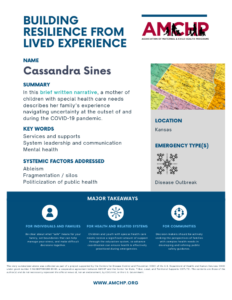A Family with Multiple Complex Medical Needs Survives a Pandemic
By Cassandra Sines
In March of 2020, when the first news of the virus started surfacing, we really didn’t know what to expect. My husband and I just watched and waited for direction from our government officials. My husband had to continue working because he was an essential employee at a medical center. Thankfully he was only exposed once in two years.
We followed all the mandates about staying home. We ordered practically everything online for pickup or delivery. All our medical appointments went virtual. While it was safe for our appointments to switch to virtual, when you have a child that is receiving a therapy such as physical therapy, it is not beneficial for it to be virtual; the parent is not trained to do the stretches that the physical therapist completes during the therapy sessions. My son has mild Cerebral Palsy, which causes tightness in his legs. He walks on his toes due to that tightness. He had Achilles’ tendon lengthening surgery in March 2019 to attempt to help with the walking on his toes, as this can cause other physical difficulties as he grows. Within a year after his surgery, he began walking on his toes again, which is why we returned to physical therapy to try and help the tightness in his legs and ankles. My son’s therapist did her best to explain to me what I needed to do for my son’s stretches; however, I don’t feel that I was able to do them appropriately due to my own weakness related to my fibromyalgia.
When our Governor in Kansas shut down schools and our youngest son’s school went to remote learning, I became his paraprofessional (“para”) since he had one at school. While I believe our district did a good job of transitioning to remote learning, there was not enough teacher involvement to support students receiving special education services. Having a 20-30 minute meeting a day with the teacher was just not appropriate, in my opinion. It left a lot of the “teaching” to the parent at home. Even when we decided to do remote learning the next school year, our son only had about 20 minutes of 1:1 time with his special education teacher, and that was after a lot of emails, two meetings to discuss my son’s Individual Education Plan (IEP) before the end of November, and lots of frustration. In my opinion, if there had been a better coordination of efforts between the education system and the health system, I do not think I would have experienced as much stress as I did. I do know that the superintendent of our school district had a committee of medical providers that he collaborated with regarding the pandemic, and he had stated many times that he utilized their input when he was putting together his COVID-19 gatekeeping recommendations to the school board. However, because the school board was the ultimate decision-maker, the medical providers’ expertise was not always taken into consideration and decisions often went against the majority of the medical providers. The only thing I would have done differently was to not engage in conversations with parents on a Facebook parent forum for our school district who thought the precautions were unnecessary and just wanted schools open with no masking. No matter what I said, I wasn’t going to change their minds. The only thing it did was add to my stress. I did, however, continue to share my family’s story with local leaders (Board of Education members, City Council members, County Commissioners) so that I could ensure that they understood that their decisions affected families with medical needs. I wanted them to have our story in mind as they were making their decisions.
Our biggest challenge was the fact that our oldest son, who lives at a private residential school for children with Autism, went on lockdown in order to protect the students and there were no parent visits. We were unable to see him for 10 months. This was the most difficult thing for all of us. He didn’t understand why we couldn’t come. While I know the school was extremely busy responding to the pandemic, I wish they would have kept the parents better informed on the status of cases on campus and what they were doing to conquer the virus. It seemed like we were left in the dark a majority of the time with respect to our children and the school. Another source of stress was the fact that our son turned 18 at the end of February 2020 and we were in the process of applying for guardianship of him when the pandemic started. When the court shut down, nothing was happening. Our son has a genetic neutropenia condition. This means that his neutrophils (his infection fighting cells) can be at a safe level one day, and a few days later they can be next to nothing. There was even a time where he was hospitalized because his neutrophils were zero. He had to have three shots of a medication that would allow his neutrophils to start developing again. I was terrified that our son would be exposed to COVID-19 at a time that his neutrophils were low and that he would get extremely sick and have to be hospitalized again. And with not having our guardianship paperwork, I was worried about how that would affect my ability to get him the care he needed and be involved in that care, since he’s not able to advocate for himself. When the court reopened in August 2020, our attorney was able to have a temporary order of guardianship signed until we were able to get our permanent order entered.
We took all the precautions we did because: (a) that’s what officials were saying to do, and (b) my family’s health. My husband has pulmonary issues. In fact, he only has about 50% function of his right lung. He also has asthma, as does our youngest son. Then add in our oldest son’s autism, genetic neutropenia and asthma. During the entire two years neither our youngest son nor myself were ever exposed or became sick with COVID. My husband was only exposed once and never tested positive. My oldest was exposed three times. Thankfully, he never got sick. We were healthy when we finally were able to go see our oldest son when the lockdown was lifted. We have all been vaccinated and all of us, except our youngest, have received boosters. My family’s “safe” is going to look very different than another family’s “safe.” For others to understand what “safe” looked like for us, the only thing I can do is explain what we did. For us, in order for us to feel safe, we need to follow all of the recommendations that were being put in place by the medical community – masking, social distancing, not traveling (at all in the beginning) or to places to where infections were high, washing hands regularly, and not going out to restaurants, entertainment, sporting events, or any other activity where there would be a lot of people. We were doing our part to keep our family safe, and we were keeping our community safe by not contributing to the spread, all of which eased our fears.
We learned that we could spend lots of time together and actually enjoy it! My husband is now in a position that he works from home full-time and we’re homeschooling our youngest. So, there’s three of us home 24/7, 365 days a year! My husband and I were on the same page about how to handle each situation resulting from the pandemic. We talked about what was going on, made a joint decision, and stuck with it as we have done numerous times throughout our marriage. We had a common goal of keeping our family safe and that was our only focus. Being a special needs family, we have a lot of practice working as a team or things don’t get done. I believe that is what helped us during this pandemic. One person was not responsible for all the decision-making, we made the decisions together. We were able to talk through our worries and fears openly together.
I would like to share with families who may ever experience an emergency of this type in the future: have someone that you can confide in, someone you can be honest with about how you’re feeling, and who can help you make difficult decisions. You do not need to make those decisions alone. And just take one day at a time. You will make it through.
By sharing I would hope that those leading health and other systems can see that a lot of thought and energy goes into decisions that families have to make during an emergency, especially when they have children with special health care needs or a loved one with a medical condition. I would hope that if our country is ever in a situation like this again (and I really hope we’re not) that we have learned lessons of how to work together and not against each other, to support one another’s decisions, and how to get through the situation stronger in the end.
View the Full “Building Resilience from Lived Experience” Series
The story and summary above were collected as part of a project supported by the Centers for Disease Control and Prevention (CDC) of the U.S. Department of Health and Human Services (HHS) under grant number 5 NU38OT000296-05-00, a cooperative agreement between AMCHP and the Center for State, Tribal, Local, and Territorial Supports (CSTLTS). The contents are those of the author(s) and do not necessarily represent the official views of, nor an endorsement, by CDC/HHS, or the U.S. Government.


